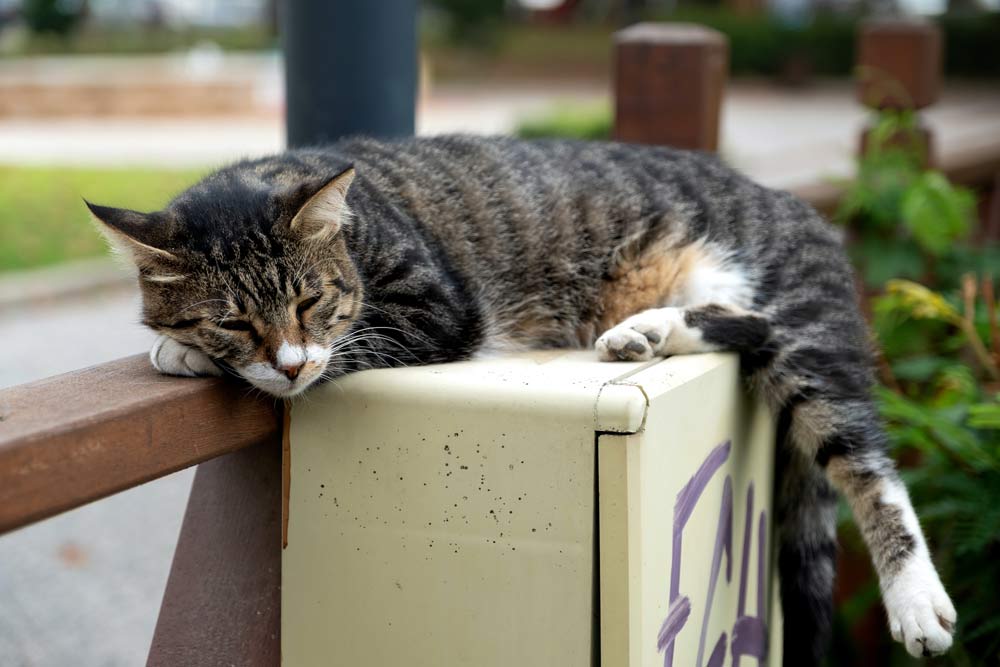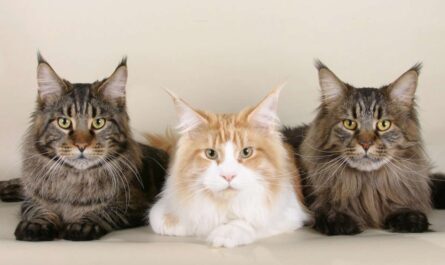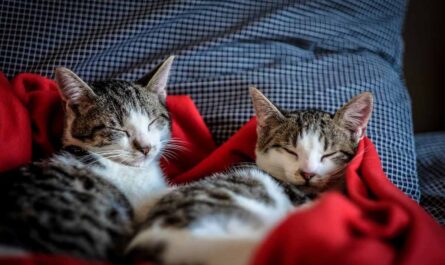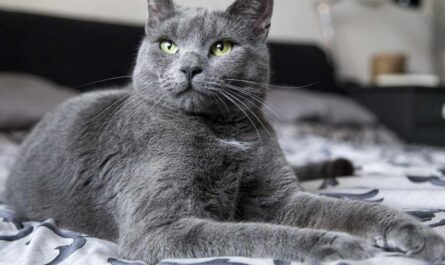Do cats feel lonely without other cats? Domestic cats, those enigmatic creatures that grace our homes with their enigmatic presence, are a nuanced blend of social and solitary behaviors. They, akin to numerous other feline species, possess an intriguing duality in their nature. On one paw, they are staunchly territorial, embarking on solitary hunting escapades rather than engaging in the collective pursuits favored by their canine counterparts. Yet, on the other paw, they exhibit a surprising inclination towards social rituals. These include collaborative feeding sessions with their furry offspring, engaging in bouts of social play, and the endearing practice of allogrooming, where feline friends engage in mutual grooming sessions. It’s this amalgamation of independence and sociability that often leaves solitary cat owners contemplating the intricate question – do cats experience loneliness without the constant companionship of their kind?
Deciphering Feline Happiness: A Conundrum of Solitude and Sociability
Delving into the psyche of a solitary cat, it becomes a perplexing endeavor to decipher their emotional state. The nuanced spectrum of feline happiness is an intricate tapestry, woven with individualistic preferences and temperament. Deciphering whether a lone cat is content in its solitude or yearns for feline camaraderie requires a careful examination of their behaviors and inclinations. Notably, the stage of life plays a pivotal role in this enigma. A whirlwind of youthful energy characterizes kittens, rendering them more inclined towards social interactions. In contrast, the older feline denizens exhibit a seasoned approach, often requiring less social engagement. Thus, the conundrum of feline loneliness becomes a kaleidoscope of age-dependent social needs.
Exploring the Depths of Feline Social Needs: Navigating the Cat Companion Conundrum
This exploration into the social needs of our feline friends unfurls a captivating narrative of intertwined instincts and individual proclivities. Cats, despite their reputation for independence, harbor an inherent sociability that manifests in varied shades. Some, the gregarious extroverts of the feline world, thrive on the company of their fellow whiskered companions. These cats revel in the joy of shared spaces, forming dynamic feline societies within the confines of a household. Conversely, there exist the stoic individualists, the lone wanderers of the feline realm, finding solace and fulfillment in the tranquility of solitude. As a discerning cat owner, understanding and respecting these diverse social inclinations becomes paramount.
To Befriend or Not to Befriend: The Cat Companionship Dilemma
In the intricate ballet of feline relationships, the question arises – should you, as a cat owner, consider introducing a feline companion to assuage the potential pangs of loneliness? The answer, like the whims of a cat chasing a sunbeam, is elusive and subjective. The decision to expand the feline family should be rooted in a nuanced comprehension of your cat’s temperament and preferences. While some cats may revel in the camaraderie of a furry friend, others may find solace in the sanctity of solo living. This decision, akin to introducing characters in a complex feline drama, demands careful consideration and an understanding of the unique dynamics that govern feline social structures.
Harmony in the Feline Abode: Navigating the Introduction of a New Cat
For those venturing into the uncharted territory of introducing a new cat into a household already graced by a feline resident, the orchestration of harmony becomes paramount. The intricacies of feline territoriality and the delicate balance of social dynamics necessitate a strategic approach. Steps must be taken with a deft hand, ensuring a gradual and gentle introduction that minimizes stress and potential conflicts. The symphony of successful cat cohabitation requires patience, understanding, and a keen eye for the subtle nuances of feline body language. Through these careful measures, the introduction of a new cat can transform the household into a harmonious haven where both feline inhabitants can thrive in companionship.
Does a single cat get lonely?
Within the tapestry of feline emotionality, the chords of loneliness find resonance. Cats, by their very nature, crave some semblance of interaction. While the solitary existence is a viable paradigm, it necessitates an infusion of human companionship, play, and environmental enrichment within the confines of their abode. The companionship of their human custodians becomes a crucial lifeline, transforming the home into a cocoon of engagement. In this delicate dance, the single cat finds solace, enveloped in the comforting embrace of a harmonious coexistence with its human counterparts.
Is it OK to have just one cat?
The singular feline presence in a household can foster contentment if paired with dedicated social interaction from their human counterparts. While cats have the potential for happiness as solitary companions, the fulcrum of their well-being pivots on the attentive engagement of their owners. To satiate their social needs, they beckon for the human touch, transforming the domestic setting into a vibrant canvas of interaction. Enrichment becomes a salient key when solitude becomes an inevitable interlude – toys, puzzle feeders, and climbing trees weave a tapestry that both stimulates and engages, ensuring the solitary feline dweller finds fulfillment within the contours of its abode.
Do cats get bored without another cat?
In the absence of a feline counterpart, the specter of boredom lurks, casting its shadow upon the solitary cat. Social interaction, whether manifested through the presence of another pet or the attentiveness of their human custodians, becomes an imperative elixir. To stave off the tendrils of ennui, a dual strategy unfolds – an active engagement that transcends the physical into the realm of mental stimulation. Solitude becomes less dreary in the embrace of puzzle feeders, cat trees, and interactive play, a symphony of stimuli that dances through the tapestry of a cat’s day, preventing the onset of boredom.
Should I allow my cat to hiss?
In the lexicon of feline expression, hissing emerges as a primal ballet, a healthy manifestation of a cat’s innate repertoire. It stands as a sentinel, a vocalized boundary communicated when a cat feels distressed and yearns for a semblance of distance. Rebuking or punishing a cat for hissing is a futile endeavor, akin to silencing a language designed to convey discomfort. Instead, honor the hiss as a natural dialogue, a communication of boundaries and emotional terrain. If the hissing becomes a relentless refrain, veering towards excess, a prudent course of action involves seeking counsel from a veterinarian to rule out underlying health vicissitudes.
The Social Structure: Solitary Nature of Felines
In the intricate tapestry of the animal kingdom, felines stand out as solitary hunters with an inherent territorial disposition. These creatures, renowned for their grace and predatory prowess, engage in a solitary existence that extends to both hunting and dining. The territorial nature woven into their feline DNA is particularly pronounced in majestic species like tigers, where the lonesome pursuit of prey and possession of territory take precedence.
The intricacies of their solo lifestyle contribute to the limited development of social skills in feline species. The solitary lifestyle is a hallmark, and while it serves them well in the wild, it sets the stage for a stark contrast with their domestic counterparts.
Social Potential of Domestic Cats
Contrary to the prevailing notion of feline aloofness, domestic cats harbor a latent potential for sociability. Drawing inspiration from their wild counterparts, domestic cats exhibit a social facet akin to that of lions, who thrive in cohesive units known as “prides.” Unlike their wild canine counterparts—dogs—who flourish in large packs, feral cats carve out a different social niche by forming modest colonies.
These feline communities are not haphazard assemblies; rather, they are strategic congregations centered around accessible food sources. Feral cat colonies, in contrast to the solitary lifestyle of many wild feline species, consist predominantly of female cats and their kittens. The dynamics within these colonies extend beyond mere coexistence, encompassing cooperative efforts in parenting and resource sharing.
Exclusion of Male Cats
Amidst the intricate dynamics of feline colonies, a notable absence echoes—the scarcity of male cats within these social units. Unlike their female counterparts, male cats veer towards a more solitary existence, eschewing the camaraderie found in feline colonies. While their territorial boundaries may intersect with those of a colony, the male feline domain is expansively solitary.
The sprawling territories carved out by male cats are a testament to their independent nature, influenced by factors such as food availability and the presence of potential mates. The absence of male involvement in feline colonies paints a vivid picture of the nuanced social tapestry woven by these enigmatic creatures, where each gender plays a distinct role in the intricate dance of survival and social dynamics.
Colonial Dynamics
Within the microcosm of feral cat colonies, a complex social choreography unfolds. The inhabitants, predominantly composed of nurturing female cats and their adorable progeny, orchestrate a delicate balance of co-parenting and communal resource utilization. The cooperative spirit reaches its zenith when familiarity among the feline denizens is coupled with an abundance of sustenance.
In this communal dance, bonds are forged, not only between mothers and their kittens but also among siblings sharing the same litter. The fabric of feline camaraderie, woven with intricate threads of mutual dependence, reveals the nuances of a social structure that defies the stereotypical image of aloof and independent cats.
Evolutionary Roots of Domestic Cats
Our beloved feline friends share a striking resemblance to their wild ancestors, drawing on a legacy of survival instincts and behaviors honed over centuries. The domestic cat, Felis catus, bears an uncanny likeness to its wild relatives, reflecting an evolutionary journey intertwined with adaptability and resilience. Despite the cozy confines of our homes, these creatures retain a primal essence, a testament to the intricate dance between genetics and the influence of their early environments.
The Delicate Balance of Feline Sociability
In the tapestry of feline behavior, a myriad of threads weaves the intricate pattern of sociability. Cats, intriguingly flexible beings, navigate a spectrum of social interactions influenced by a combination of genetics, early environmental experiences, and the dynamic impact of their human counterparts. The feline temperament, a delicate dance of nature and nurture, unfolds in the backdrop of our shared domestic spaces. This adaptability grants cats the unique ability to thrive in both solitary and social settings, enriching the tapestry of our homes with their presence.
Companionship Dynamics Among Cats
Within the realm of feline companionship, a diverse array of dynamics unfolds. Cats, with an enigmatic grace, embrace the company of their kind or find solace in the presence of other pets and human family members. A captivating spectrum emerges: some cats actively seek social bonds, displaying an eagerness to forge connections with fellow felines or their human counterparts. Conversely, silent contentment resides in the hearts of cats who revel in solitary bliss, embracing the quietude of independence within the walls of our homes.
The Social Tapestry of Kittens
In the enchanting world of kittens, social needs take center stage, weaving a tapestry of youthful exuberance and camaraderie. These playful bundles of fur, in their tender stages of life, embark on a journey of discovery, craving playmates to illuminate the path of social interaction and hone essential hunting skills. At this formative stage, kittens not only form special bonds with their littermates but also extend their affections to companions from separate litters. The intricate dance of socialization and learning becomes a cornerstone in their development, laying the foundation for the adults they will become.
Adulthood: A Diverse Landscape of Feline Preferences
As kittens gracefully transition into the realm of adulthood, the varied landscapes of feline preferences come to the forefront. Some cats, akin to eternal youths, carry the torch of their youthful love for play and social interaction into their mature years. These perpetual kittens find fulfillment in the company of others, perpetuating the lively spirit of their youth. On the contrary, a subset of feline companions relishes the serenity of single-cat households, basking in the tranquility of solitary existence. The diverse mosaic of feline preferences paints a captivating portrait of individuality within our homes.

The Delicate Balance: Solitude and Social Bliss
In the delicate dance of feline companionship, the paradox of a cat’s happiness lies at the crossroads of solitude and sociability. A cat, despite finding contentment as a lone entity, is inherently wired as a social species, harboring a latent appreciation for companionship. The introduction of a new cat into this complex equation may seem a daunting task, akin to navigating a labyrinth, yet success lies in embracing a methodical and gradual approach, unfurling the layers of feline connection one step at a time.
A Tapestry of Feline Happiness: The Singular and the Social
Within the feline realm, the concept of happiness emerges as a multifaceted tapestry, woven with threads of solitude and social engagement. A solitary cat, though content, may find an additional layer of fulfillment in the presence of a feline companion. The intricacies of their interactions, reminiscent of a delicate ballet, underscore the nuanced nature of feline social dynamics, adding a layer of depth to the enigma of their happiness.
Navigating the Social Landscape: Insights into Feline Companionship
In the vast landscape of feline companionship, understanding the nuances becomes paramount. The introduction of a new cat into the equation necessitates careful navigation, akin to a slow waltz. Each step, laden with significance, paves the way for a harmonious coexistence. The journey towards successful feline camaraderie unfolds in the measured pace of understanding, acknowledging the intricacies of their social landscape.
Societal Complexities: Deciphering the Language of Feline Bonds
Deciphering the language of feline bonds requires an exploration of societal complexities inherent in their nature. While a cat may find solace in solitude, the underlying desire for social connection remains a latent force. The artistry of introducing a new feline companion lies in the delicate brushstrokes of observation and understanding, painting a canvas that reflects the intricate dynamics of their evolving relationship.
Step-by-Step Harmony: Crafting Feline Companionship with Precision
Crafting the symphony of feline companionship demands a meticulous approach, akin to a composer orchestrating a masterpiece. The step-by-step process of introducing a new cat unfolds as a precise art, requiring patience and attentiveness. Each moment becomes a note in the melodic journey toward harmony, creating a masterpiece of feline camaraderie that resonates with the delicate balance of solitude and social bliss.
Ways to Tell If Your Cat Is Lonely
Understanding the nuanced cues that signify loneliness in your cat involves a comprehensive examination of their behavioral, vocal, grooming, eating, and sleeping patterns, as well as a keen awareness of any destructive tendencies. By attentively decoding these subtle signals, you can provide the companionship and support necessary to alleviate their emotional distress and ensure the well-being of your cherished feline friend.
1. Vocalization Patterns
The lexicon of feline vocalizations, like a cryptic language written in the whispers of meows and yowls, holds the key to deciphering the intricate emotions that dance within the soul of your cat. In the realm of loneliness, their vocal expressions become a poignant symphony, an orchestration of plaintive meows that echo through the halls of your shared space. Yowls, once sporadic, stretch into prolonged soliloquies, a desperate plea for connection that reverberates through the air. The frequency of sounds, a deviation from the familiar cadence of communication, becomes a Morse code of yearning. Each rise in volume, each intensification, is an intricate brushstroke painting the canvas of their isolation. To grasp the depth of their solitude, one must attune their senses to the subtle nuances, interpreting the hidden emotions etched within the melodic contours of feline vocalization.
2. Changes in Eating Patterns
The intricacies of your feline companion’s dining habits can serve as a window into the complex landscape of their emotions. When loneliness infiltrates their world, it has the power to disrupt the well-established rhythm of their feeding routines. This disruption might manifest as a sudden surge in food consumption, a desperate attempt to fill the emotional void. Conversely, some cats, besieged by isolation, might find solace in abstaining from their meals altogether, their appetite vanishing like shadows in the night. Vigilantly monitoring these fluctuations in dietary patterns becomes an art of decoding their emotional distress, a nuanced language that hints at the need for increased companionship. Weight fluctuations, like the subtle rise and fall of emotional tides, become the markers to decipher the unspoken language of your feline friend’s solitude.
3. Behavioral Changes
In the intricate tapestry of feline emotions, subtle alterations in behavior unfurl like delicate threads, weaving a narrative of your cat’s inner world. A solitary cat, once a vivacious ball of fur, may undergo a metamorphosis in demeanor, shedding the layers of playfulness like autumn leaves. Lethargy becomes their silent companion, and the vibrant curiosity that once defined them dwindles into a muted echo. They retreat to the shadows, seeking solace in secluded corners, withdrawing from the symphony of routine interactions that once defined their existence. Activities that once held the allure of enchantment now fail to captivate their attention, and a palpable disinterest settles upon them like a shroud. The reluctance to partake in customary activities becomes a poignant semaphore, signaling the potential loneliness that has cast its shadow upon your beloved feline companion.
4. Decreased Grooming Habits
In the realm of feline fastidiousness, where each lick is a ritual of self-care, a decline in grooming habits stands as a stark testament to the emotional upheaval gripping your cat’s soul. Renowned for their meticulous attention to coat cleanliness, lonely cat relinquishes this sacred routine, allowing their fur to lose the gloss of well-tended elegance. The brush of a paw against their fur becomes a languid gesture, lacking the vigor that once defined their grooming rituals. What was once a symphony of self-love becomes a muted melody, a tangible manifestation of their emotional disarray. The neglect of their once-prized coat unveils the hidden turmoil, a silent scream that echoes through the unspoken language of feline distress. The discerning eye, keenly attuned to these deviations, becomes a translator of the unspoken, revealing the emotional landscape your feline friend navigates in the wilderness of loneliness.
5. Excessive Sleeping
The cat’s affinity for prolonged siestas is a well-known aspect of their demeanor, but when lethargy transcends the boundaries of the ordinary, it becomes a subtle semaphore signaling underlying loneliness. The feline, grappling with the void of social isolation, might find refuge in the embrace of excessive slumber, a cocoon shielding them from the harsh reality of solitude. The key lies in observing not just the duration but the deviation from their established sleep patterns – those sacred rhythms that normally govern their rest. An uptick in the frequency and duration of their naps becomes the cryptic Morse code, the silent plea for companionship reverberating through the lullabies of solitude.
6. Destructive Behavior
Loneliness, the silent specter haunting the corners of your cat’s world, seldom remains confined within. It seeks an outlet, a vent for the emotional tempest brewing within their delicate frames. This tumult, often taking the form of destructive behavior, manifests as claw marks etched into furniture like a desperate cry for attention, excessive scratching akin to an impassioned plea, or gnawing at objects as a symbolic attempt to consume the void. Recognizing these destructive tendencies becomes an art of interpretation, a decoding of the feline hieroglyphs that scream their unmet needs. It’s not just about salvaging furniture; it’s about redirecting their emotional energy towards more positive outlets, a collaborative effort to quell the storms within and restore the tranquility of their emotional landscape.
Should I Get A Second Cat?
In unraveling the mysteries of feline companionship, the nuances and contradictions echo through the corridors of their enigmatic world, a tapestry woven with threads of solitude, sociability, and the delicate dance between them. Understanding the intricate tapestry of cat behavior requires navigating through the complex interplay of solitude and sociability within their enigmatic world. While mother and kitten family groups are characterized by exuberant sociability, the demeanor of adult cats, particularly males, tends to lean towards a more solitary disposition, injecting an element of unpredictability into their inter-feline relationships.
The Complexity of Cat Companionship: Unraveling the Enigma
Deciphering the dynamics of feline companionship proves to be an intricate puzzle, defying straightforward predictions about which cats will harmonize and which might thrive in solitude. The enigmatic nature of feline behavior manifests in subtle cues that indicate loneliness, such as a cat clandestinely retreating to the shadows, emitting a plaintive meow that echoes with solitude, or manifesting a clinginess that borders on a silent plea for companionship. On the flip side, solitary cats may unravel their discontent through destructive escapades and an orchestra of excessive vocalization that resonates through the solitude of an empty space. Cat accessories on Amazon
Challenges in the Harmony: When Solitude Prevails
For adult cats, especially those accustomed to the solitary rhythm of their lives, the addition of a new feline member can transform the melody into a discordant note. Those who have traversed the majority of their existence in solitary splendor or were untimely separated from their maternal haven and littermates may resist the inclusion of a new feline compatriot. Signs of stress emerge as silent symphonies, played out through clandestine retreats, litter box rebellions, meticulous bouts of excessive grooming, or a disheartening loss of appetite. In these instances, the addition of a second cat may inadvertently amplify the dissonance, transforming what was envisioned as a harmonious duet into a cacophony of feline distress.
The Intricacies of Feline Compatibility: A Symphony of Social Traits
Navigating the labyrinth of feline compatibility reveals a spectrum where certain cats emerge as ideal candidates for companionship. Those who dance effortlessly in the realms of playfulness or sociability, flaunting a history of camaraderie with their feline peers during their formative years, stand poised to reap the benefits of a feline companion. The absence of stress or anxiety signals in these feline individuals marks them as prime candidates for the introduction of a fellow feline into their lives. See why thousands of cats love BoxCat
Early Bonds and Feline Affinity: A Prelude to Harmony
In the symphony of feline relationships, kittens emerge as virtuosos, effortlessly weaving bonds with newfound companions. The delicate dance of early introductions unfolds as a crucial overture, shaping the future harmony between cats. The canvas upon which these relationships are painted is particularly receptive during the kitten stage, establishing foundations that endure through the crescendos of feline camaraderie. For those cats left to navigate the vast stretches of solitude, a companion becomes a beacon of solace, especially if the shadows of separation anxiety or the cacophony of destructive behaviors cast a gloom over their solitary existence.
Other Interesting Articles
- Ocicat Cat Breed Profile: Health, Facts, Traits, Groom, Care
- Ojos Azules Cat Breed Profile: Health, Traits, Groom, Care
- Oregon Rex Cat Breed Profile: Health, Traits, Groom, Care
- Oriental Bicolor Breed Profile: Health, Traits, Groom, Care
- Oriental Longhair Breed Profile: Health, Traits, Groom, Care
- Oriental Shorthair Breed Profile: Health, Traits, Groom, Care
- Peterbald Cat Breed Profile: Health, Traits, Groom, Care
- Pixie-Bob Cat Breed Profile: Health, Traits, Groom, Care
- Ragamuffin Cat Breed: Health, Facts, Traits, Groom, Care
- Russian White Cat Breed Profile: Health, Traits, Groom, Care
- Serengeti Cat Breed Profile: Health, Traits, Groom, Care
- Savannah Cat Breed Profile: Health, Traits, Groom, Care
- Selkirk Rex Cat Breed Profile: Health, Traits, Groom, Care
- Singapura Cat Breed Profile: Facts, Coat, Traits, Groom, Care
- Sokoke Cat Profile, Traits, Health, Facts, Grooming, Care
- Somali Cat Profile, Traits, Health, Facts, Grooming, Care
- Turkish Angora Cat Profile, Traits, Health, Grooming, Care
- Sphynx Cat Breed: Profile, Traits, Health, Grooming, Care
- Turkish Van Cat Breed: Profile, Traits, Grooming, Care
- Toyger Cat Breed: Profile, Traits, Health, Grooming, Care



